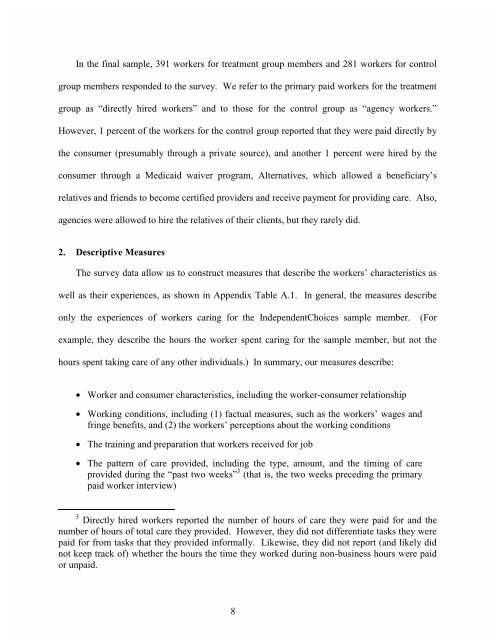The Experiences of Workers Hired Under Consumer Direction in ...
The Experiences of Workers Hired Under Consumer Direction in ...
The Experiences of Workers Hired Under Consumer Direction in ...
Create successful ePaper yourself
Turn your PDF publications into a flip-book with our unique Google optimized e-Paper software.
In the f<strong>in</strong>al sample, 391 workers for treatment group members and 281 workers for controlgroup members responded to the survey. We refer to the primary paid workers for the treatmentgroup as “directly hired workers” and to those for the control group as “agency workers.”However, 1 percent <strong>of</strong> the workers for the control group reported that they were paid directly bythe consumer (presumably through a private source), and another 1 percent were hired by theconsumer through a Medicaid waiver program, Alternatives, which allowed a beneficiary’srelatives and friends to become certified providers and receive payment for provid<strong>in</strong>g care. Also,agencies were allowed to hire the relatives <strong>of</strong> their clients, but they rarely did.2. Descriptive Measures<strong>The</strong> survey data allow us to construct measures that describe the workers’ characteristics aswell as their experiences, as shown <strong>in</strong> Appendix Table A.1. In general, the measures describeonly the experiences <strong>of</strong> workers car<strong>in</strong>g for the IndependentChoices sample member. (Forexample, they describe the hours the worker spent car<strong>in</strong>g for the sample member, but not thehours spent tak<strong>in</strong>g care <strong>of</strong> any other <strong>in</strong>dividuals.) In summary, our measures describe:• Worker and consumer characteristics, <strong>in</strong>clud<strong>in</strong>g the worker-consumer relationship• Work<strong>in</strong>g conditions, <strong>in</strong>clud<strong>in</strong>g (1) factual measures, such as the workers’ wages andfr<strong>in</strong>ge benefits, and (2) the workers’ perceptions about the work<strong>in</strong>g conditions• <strong>The</strong> tra<strong>in</strong><strong>in</strong>g and preparation that workers received for job• <strong>The</strong> pattern <strong>of</strong> care provided, <strong>in</strong>clud<strong>in</strong>g the type, amount, and the tim<strong>in</strong>g <strong>of</strong> careprovided dur<strong>in</strong>g the “past two weeks” 3 (that is, the two weeks preced<strong>in</strong>g the primarypaid worker <strong>in</strong>terview)3 Directly hired workers reported the number <strong>of</strong> hours <strong>of</strong> care they were paid for and thenumber <strong>of</strong> hours <strong>of</strong> total care they provided. However, they did not differentiate tasks they werepaid for from tasks that they provided <strong>in</strong>formally. Likewise, they did not report (and likely didnot keep track <strong>of</strong>) whether the hours the time they worked dur<strong>in</strong>g non-bus<strong>in</strong>ess hours were paidor unpaid.8
















